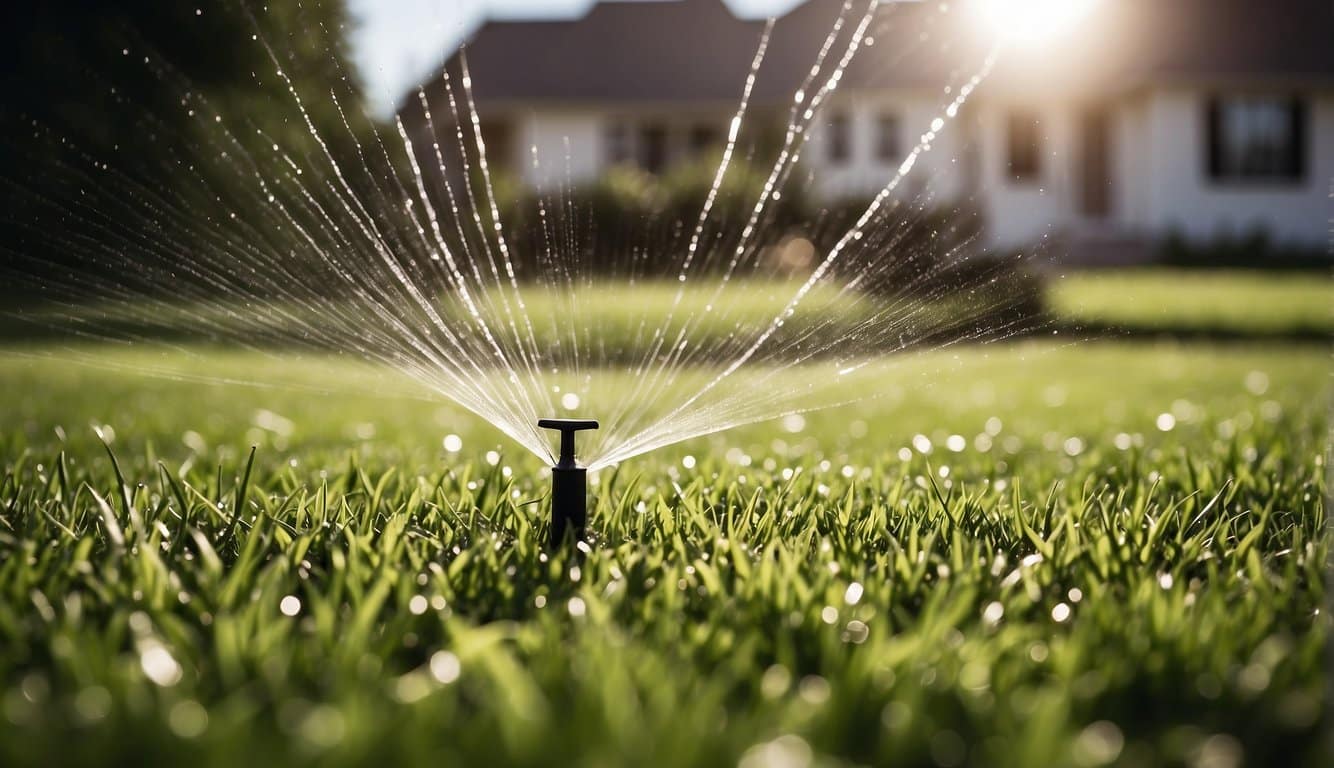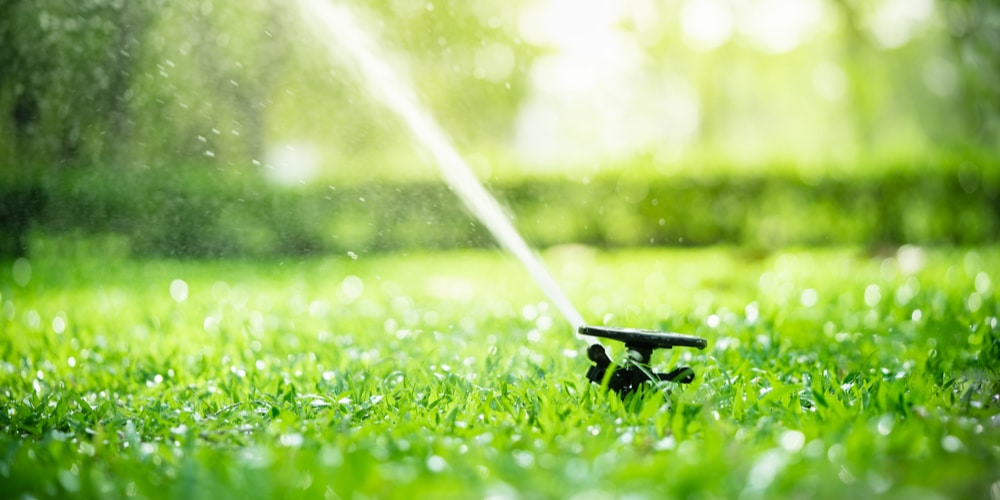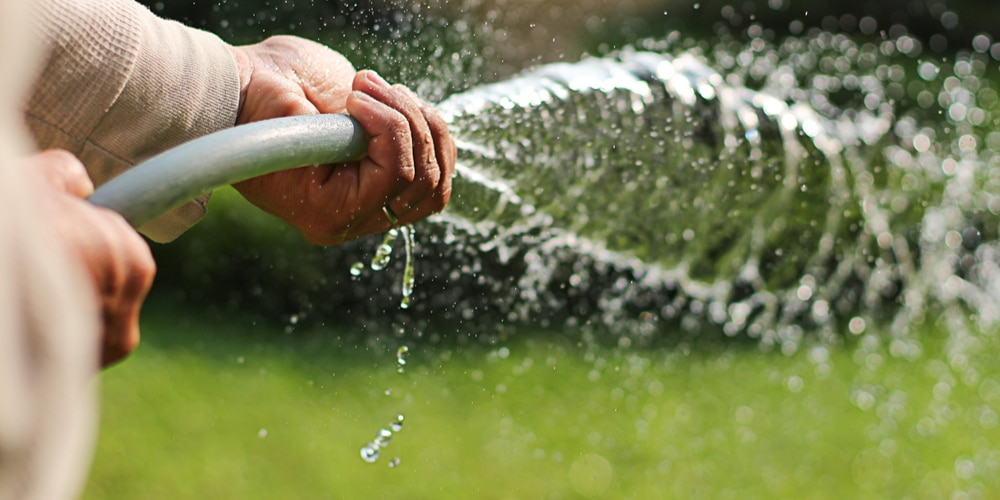Understanding Illinois Climate and Lawn Requirements
The climate in Illinois can pose a challenge for lawn maintenance, especially during the summer.
Your lawn’s water needs are greatly influenced by local weather patterns, soil type, and grass species.
Cool-season grasses, including Kentucky bluegrass, perennial ryegrass, and fine fescues, commonly found in Illinois, have particular watering requirements.
During the hot and often humid summer months, these grasses can experience stress, requiring careful watering to stay healthy.
Key Factors Affecting Lawn Watering in Illinois:
- Soil type: Different soils retain moisture differently, with clay soils holding water longer than sandy soils.
- Weather conditions: Temperature, humidity, and precipitation dictate how much water your lawn will need week-to-week.
Recommended Watering Practices:
- Frequency: Aim to water about 1 to 1.5 inches per week, adjusting for rainfall.
- Time of day: The optimal time to water is in the early morning, between 5:00 am and 10:00 am, to minimize evaporation and reduce the risk of fungal diseases.
Effective Lawn Watering Tips:
- Measure water output: Use a rain gauge to track how much water your lawn is receiving naturally and adjust accordingly.
- Observe lawn health: If the grass blades are wilting or the ground is cracking, it’s a sign that your lawn needs water.
- Follow local guidelines: Be aware of any municipal watering restrictions due to conservation efforts, especially during drought conditions.
Lawn Watering Techniques
Proper lawn watering techniques are essential for maintaining a healthy summer lawn in Illinois. Striking the right balance between providing enough moisture and conserving water can be challenging, but with the right strategies, you can keep your lawn green and vibrant.
Timing and Frequency
Best Time to Water:
- Early Morning: Ideally between 5:00 AM and 10:00 AM to minimize evaporation and disease risk.
Frequency:
- Dormant Lawns: About 1/2 inch of water every few weeks to keep the plant crowns hydrated.
- Active Growth: Once the lawn resumes natural growth, watering can be adjusted accordingly.
Water Conservation Methods
- Use mulch to help the soil retain moisture and reduce evaporation.
Even Water Distribution:
- Ensure water is spread evenly across the lawn to prevent dry spots and water wastage.
Cycle and Soak Method:
- For Clay Soils: Break the watering session into multiple cycles with intervals to allow water to soak into the soil.
Equipment and Tools for Effective Watering
Choosing the right equipment for watering your lawn can make a significant difference in the health of your grass and the conservation of water. From automated systems to simpler hose attachments, the following tools will help you efficiently manage your lawn’s hydration needs.
Sprinkler Systems
Automated Sprinkler Systems are a convenient way to ensure your lawn receives even coverage of water. Modern systems can be programmed to water at optimal times, usually early morning, and can adjust their schedules based on the weather.
When selecting a sprinkler system:
- Choose one with adjustable spray ranges to match the shape and size of your lawn.
- Consider smart systems with weather sensors to prevent watering before, during, or after rainfall.
Hose-End Sprinklers
Hose-End Sprinklers are less costly than in-ground systems and are great for smaller or irregular shaped lawns. They come in various types like oscillating, stationary, and impulse sprinklers.
For effective use:
- Match the sprinkler type to your lawn shape: oscillating for rectangular areas, rotating for larger, circular areas.
- Ensure the sprinkler has a timer to prevent over-watering.
Drip Irrigation
Drip Irrigation Systems are especially suited for garden beds but can be adapted for use in lawns to target water directly to the roots with minimal evaporation.
When using drip irrigation:
- Install a pressure regulator to ensure a steady, low-pressure flow of water.
- Use a filter to keep emitters from clogging with sediment present in the water supply.
Maintaining Lawn Health During Drought Conditions
During drought conditions, your lawn care approach must shift to prioritize water conservation while maintaining the health of your grass. Follow these strategies to ensure your lawn remains resilient:
Watering Schedule: Adjust your watering routine to provide about 1-1.5 inches of water weekly, allowing for deep soil penetration. Aim for early morning irrigation to reduce evaporation.
- Monday: 0.5 inches
- Wednesday: 0.5 inches
- Friday: 0.5 inches
Grass Height: Keep grass blades longer to shade roots and soil. Mow at the highest setting your mower allows, which usually translates to about 3-4 inches tall.
Monitor Lawn Health: Use a screwdriver to test soil moisture. If it goes in easily, your lawn is hydrated. If it’s difficult, it’s time to water.
Fertilization: Postpone fertilizing as it encourages growth that demands more water. Stick to essential maintenance only.
Key Practices
- Mulching: Mulch clippings back onto the lawn to provide natural nutrients and moisture retention.
- Aeration and Dethatching: Delay these activities to minimize stress on your lawn.
- Dormancy: Allow your lawn to naturally go dormant if necessary. It’s a built-in survival mechanism.
Monitoring and Adjusting Watering Schedules
To maintain a healthy lawn throughout the Illinois summer, it’s essential to monitor and adjust your watering schedules. Your lawn’s hydration needs vary with fluctuating temperatures and weather conditions.
Initial Schedule:
Begin with a foundational schedule of 1 to 1.5 inches of water per week. This can be dispersed across two watering sessions.
Timing:
- Ideal Time: Water between 5:00 am and 10:00 am to reduce evaporation and fungal growth risks.
- Avoid: Nighttime watering to prevent disease and midday sessions to minimize water loss.
Adjusting for Weather:
- Excessive Heat: Increase frequency while keeping the weekly total water amount consistent.
- Rainfall: Natural precipitation can reduce the need for watering. Adjust your schedule accordingly.
Soil Testing:
- Conduct periodic soil moisture tests.
- If the soil is dry at a 6-inch depth, it’s time to water.
| Temperature | Adjustment |
|---|---|
| Below 85°F | Standard schedule |
| 85°F – 90°F | Increase by 25% |
| Above 90°F | Increase by 50% or more |
Tech Tips:
- Utilize rain sensors or smart irrigation systems to automate adjustments.
- Regularly inspect your irrigation system for any leaks or misaligned sprinklers.
Frequently Asked Questions
Proper lawn watering is key to maintaining a lush and healthy garden. These FAQs will guide you in ensuring your Illinois lawn stays vibrant during those warm summer months.
What is the recommended frequency for watering my lawn during the peak summer months in Illinois?
During the peak summer months, it’s best to water your lawn about once every few weeks to keep the plant crowns hydrated. One-half inch of water is sufficient during dormancy, but you will need to increase frequency to about one to 1.5 inches per week once active growth resumes.
How long should I run my sprinklers to adequately water my lawn?
The duration of watering should provide your lawn with approximately one to 1.5 inches of water each week. Specific times will vary depending on your sprinkler system and water pressure, but generally, it might take about 20-30 minutes per zone, a couple of times a week.
Is it more beneficial to water my lawn in the morning or evening to prevent evaporation?
The optimal time to water your lawn is in the morning, between 5:00 am and 10:00 am. This helps to minimize evaporation and allows the grass to dry before nightfall, reducing the risk of fungal diseases which can thrive in damp conditions.
Can overwatering my lawn cause damage during the summer, and how can I avoid it?
Yes, overwatering can be detrimental, leading to fungal diseases and a shallow root system.
To avoid this, make sure you are not watering your lawn more than the recommended one to 1.5 inches per week. Also, adjust your watering schedule based on rainfall.
What signs should I look for to determine if my lawn is properly hydrated?
A well-hydrated lawn will have a vibrant green color and the grass blades will rebound quickly after being stepped on.
If the grass blades stay flattened, it might be a sign that the lawn needs more water. Also, check the soil moisture by probing it with a screwdriver or soil probe; it should feel damp to a depth of 6-8 inches.
Are there any regional water restrictions in Illinois that I should be aware of when planning my lawn watering schedule?
Water restrictions can vary based on local ordinances and drought conditions.
Check with your local government or water utility company to ensure that you comply with any restrictions or recommended watering schedules in your area.



